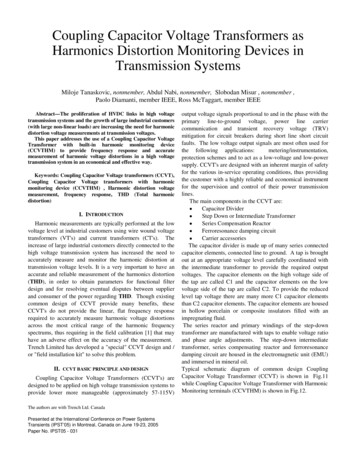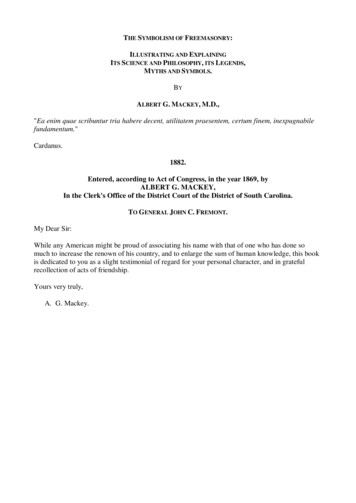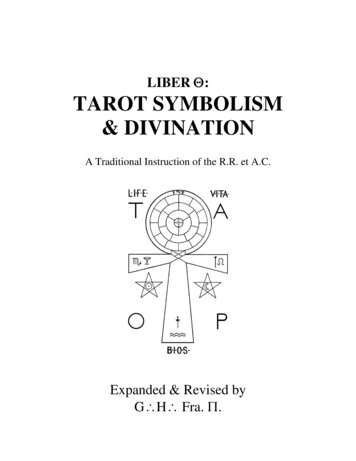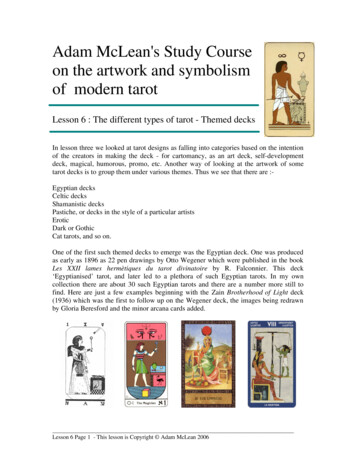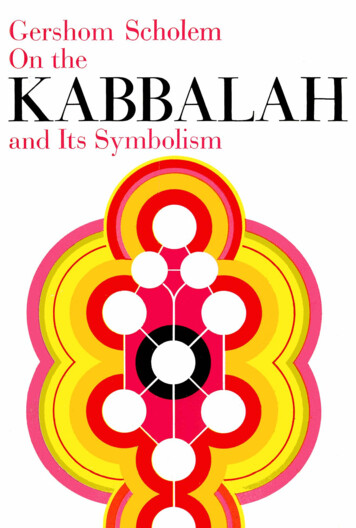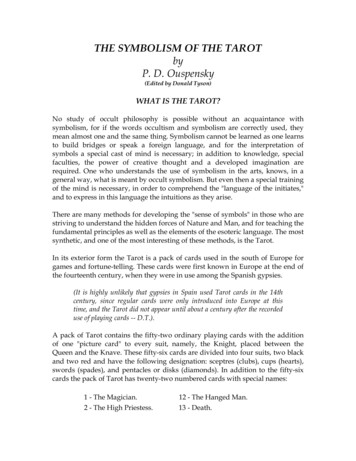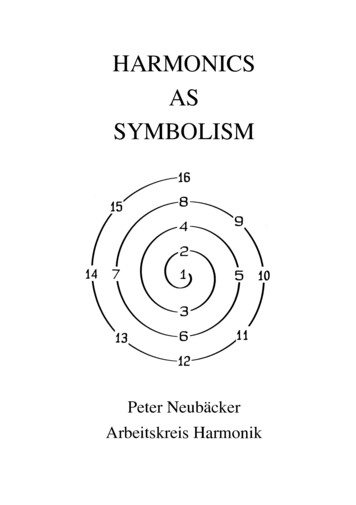
Transcription
HARMONICSASSYMBOLISMPeter NeubäckerArbeitskreis Harmonik1
CONTENTSPART 1: WHAT IS ‘HARMONICS’?The Origins3Johannes Kepler - The rational way7The Music of the Spheres10Harmonics today14The Lambdoma – order and symbol17The tonal structure of the number world21A harmonical cosmogony25PART 2: HARMONIC SYMBOLISMDedicated toProf. Dr. Rudolf HaaseFounder of the Hans Kayser Institutein Vienna For Basic Research In Harmonicson the occasion of his 70th birthday on the 19.2.1990Expanded transcript of the lecture„Symbolische Inhalte der mathematisch-musikalischenBeziehungen in der Pythagoräischen Harmonik“delivered during the symposium „Kult-Mythen-Symbole“28.9.-1.10.1989 in Brixen2
PART 1: WHAT IS ‘HARMONICS’?The OriginsWhen one speaks of Pythagorean harmonics, it is not ‘harmonics’in the sense of overtones nor is it the theory of harmony in music thatis to be understood; but rather the meaning of the word goes furtherback to the Greek word ‘harmotto’ – which means something like ‘toordain’ or ‘order’: one is looking, then, here at how things relate toeach other and are ordered, and the assumption is that this order canbe expressed in musical terms. The primary significance of the epithet ‘Pythagorean’ here is not something historical, something relating to the teachings of Pythagoras, but serves to characterize moreclosely a particular way of considering things – when one speaks ofPlatonic ideas, one does not mean the ideas of Plato either, of course,but a very specific characteristic way of dealing with the world ofideas.With harmonics, it is also about something akin to Platonic ideas,that form the subsoil of music, and as we shall see, not only the subsoil of empirical music: Music is understood here as something thatmakes audible and crystallizes archetypes or ideas, as world-matter,with which the musician plays and with which the soul deals whenman hears music.To be able to understand these connections better, we must enter aterritory in which philosophy moves between mathematics and music. At first sight, the involvement of mathematics may seem unfamiliar and contradictory, but if one looks back in the history of ideas,one realizes that there were times in which this involvement wasconsidered perfectly natural. I should like here to provide a smalloverview of how these ideas, which lie at the heart of what we todaycall harmonics, developed historically.Men in earlier times had – and still may have today in primitivecultures – a natural sense that the entire world in its structure wassomehow related to music. The creation myths of many peoples tes-3
tify to this – the Indian myth, for example, that the Creator-Godthrough singing caused the lump of earth in his hands to grow – asdoes the fact that the Polynesians use the same word for ‘world’ and‘singing’: langi – the universe and lalolangi – the lower singing: theEarth.For our cultural area there is in ancient Greece the cult of Orpheus, in which music played the central role – as a power thatstemmed from the source of the world. In all these old cultures it wastherefore clear that music is a creative elemental force – to themagical-mystical consciousness that was a very natural feeling.Now around two and a half thousand years ago a new elementappears: the burgeoning rational thought is no longer satisfied withthe instinctive feeling that the world is based on a musical structure –man also wants to know what this structure is like. The key figure forthis process in Greece is Pythagoras. He had spent the first half of hislife as a student of the mysteries in Egypt and Babylon, where healso studied the further developed mathematics there before returning to the Greek cultural area and founding in Croton in SouthernItaly a school of philosophy and an order.Nothing written by Pythagoras himself has been handed down tous, but the influence of his thought in the period that followed was sogreat that traces of his teachings, from which his world view can bededuced, are to be found everywhere. In Plato’s Dialogues, for example, Pythagoreans appear who represent his cosmogony: here thecreation of the world appears as at once a mathematical and a musical process, and Aristotle, too, says of the Pythagoreans: “since.they saw that the modifications and the ratios of the musical scaleswere expressible in numbers; - since, then, all other things seemed intheir whole nature to be modelled in numbers, and numbers seemedto be the first things in the whole of nature, they supposed the elements of numbers to be the elements of all things, and the wholeheaven to be a scale and a number.”What is new here is the idea of the mathematical structure of theworld that has been added to the musical, and also new is that these4
connections were not taught as articles of faith but the Pythagoreansconducted active research in an attempt to learn more about thesestructures of the world. The instrument of research that Pythagorasintroduced for the purpose was the monochord: a single-stringed instrument not primarily intended for making music but for conductingmeasurements. With its help, the Pythagoreans were able to establishthat “. the laws of musical harmony can be represented in numbers.” If, in other words, the string of the monochord is divided insuch a way as to create a euphonious musical interval, it emerges thatthe divisions of the string form a particular numerical ratio, and thesmaller the numbers involved, the more pleasant the sound of theinterval. The first two numbers, for example, the One and the Two,yield the octave, the foundation of all music, and from the numbersTwo and Three we obtain the fifth, from which all the other notes canbe generated.One can say that with the monochord Pythagoras introduced thefirst scientific instrument of experimentation, and even today themonochord remains the most important tool of harmonicists. Themonochords of today generally have multiple strings all the samelength and identically tuned so that by placing small bridges beneaththe strings, it is possible to set and hear different numerical ratios atthe same time.Figure 1: A monochord5
One important characteristic, however, distinguishes the monochord from what we would think of today as a scientific instrumentof experimentation: through the fact that one is on the one hand dealing with numbers but on the other hand experiencing these numbersdirectly through hearing it connects these two worlds with one another: the inner world of experience with the external world ofmeasurement and calculation – it creates a link, in other words, between the qualitative and the quantitative.Of Pythagoras it is also said that he was the first to describe theworld as a ‘cosmos’ – and cosmos means ‘order’ or ‘decoration’.This word is therefore related in meaning to the term ‘harmonics’,since this is to be understood as derived from ‘harmotto’ in the senseof ‘order’ – harmonics, in other words, is a study of the structures ofthe whole world – and the practice of ‘listening to them’ on themonochord.To the ancients, then, the musical foundation of the world was apremise they took for granted – what was new was the idea that thiscould be grasped rationally through numbers. Through the vivid association of the number with the sound, the numbers were not, as formost people today, dead abstract constructs but living beings whosecharacter and quality could be experienced through hearing.The Pythagoreans comprised the Mathematici and the Acusmatici– the word Mathematici here, however, is not to be understood as‘mathematicians’ in today’s sense. The Mathematici were those whoattempted to penetrate the essence of things through their own research as opposed to the Acusmatici, the ”Listeners”, who adoptedthe teachings of Pythagoras as maxims to live by.As is usually the case, a system of statements and rules survivedfrom the teachings of Pythagoras that the ‘Acusmatici’ of later timesscarcely understood correctly but to the ‘Mathematici’ in the Pythagorean sense an impetus was given that even today lives on inharmonics.6
From Pythagoras onwards, the connection between music andmathematics was familiar to all later philosophers and mathematicians (which were still one and the same at that time) and an important foundation of thinking and research. The mathematician Euclid,for example, also wrote a book about music and its mathematicalfoundations and the astronomer and geographer Ptolemy describes inhis musical work studies with a 15-string monochord as still usedtoday.Johannes Kepler – The rational wayThe Pythagorean world view, therefore, was alive throughout theclassical era and middle ages, with the ideas of the Harmonia Mundiand Harmony of the Spheres particularly popular. But in the scholastic philosophy of the Middle Ages, one began primarily from thoughtitself, and philosophical investigation proceeded more geometrico –in the manner of geometry. The Harmony of the Spheres had becomea fixed part of the intellectual edifice, and no one asked about themanner in which this harmony – in the movement of the planets, forexample – manifested itself in the external world.It was not until the Renaissance era – around the 16th centuryonwards – that research began once again to examine external nature. For harmonic research, Johannes Kepler (1571-1630) is themost important figure here. Since Kepler’s thought and research isespecially characteristic of the manner of thinking of the new harmonics, I should like to discuss him in greater detail.From his youth onward, Johannes Kepler was convinced that theentire world was harmonically ordered according to particular laws,and unlike the attitude of mind of the ancients he was also of theopinion that this order could be discovered through research into external nature. When today in school we learn Kepler’s three laws ofplanetary motion, we are not normally told that these laws were forhim simply a by-product of his search for the musical harmony of theworld, which he then also discovered in fact.7
Kepler’s formulation of the question was an unusual one compared with the approaches to natural research today: from the laws ofheavenly mechanics known to us today one can admittedly calculatehow far away from the sun a planet is throughout an observed revolution period – but as to why it is exactly this distance and has thisrevolution period rather than another, there are no clues. It was justthis question that interested Kepler and this manner of contemplationis typical of the harmonic way of thinking: It is a question thereforeof discerning correlations with a perceptible character that contain a‘physiognomic’ testimony for the observer; the functional relationships are of secondary importance. The question is similar to that ofwhy the Rosaceae are constructed upon the number Five and theLiliaceae upon the number Three: modern science is incapable notonly of answering such questions but even of putting them, sincecontemplation of this kind has no place in its system of thought.Initially Kepler’s search for the ordering principle of the solarsystem rested on an idea that was more geometrical than musical: Atthe age of 23, when he was a professor of mathematics in Graz, theidea came to him in the middle of a lecture that the structure of thesolar system might be based on the geometry of the Platonic solids.These are the regular polyhedra that were described for the first timeby Plato: if you attempt to construct geometric solids the faces ofwhich are identical regular polygons that meet at the same threedimensional angles, it turns out that only five are possible: the bestknown is the cube, which is constructed from six squares; from equilateral triangles it is possible to construct three such polyhedra; thetetrahedron with four, the octahedron with eight, and the icosahedronwith twenty faces; the last of the Platonic solids is the dodecahedron,which is formed from twelve pentagons. The five solids are shown inFigure 2, a page from Kepler’s later work Harmonices Mundi: superimposed here on each of the five polyhedra is a drawing representingone of the elements (fire, water, air, earth and the cosmos or ‘quintaessentia’) – the assignments being the same as those found in Plato.8
Figure2 : From the 2nd volume of WeltharmonikThese five solids have the characteristic that one can inscribethem with a sphere that touches all their faces from the inside andcircumscribe them with a sphere that touches all their vertices fromthe outside. If you now nest the five bodies in such a way that theouter sphere of one polyhedra is the inner sphere of the next, youarrive at the model illustrated in Figure 3. The resulting sequence ofradii corresponds with astonishing accuracy to the distance of theorbits of the planets from one another. Kepler first published this discovery in 1596 in his work Mysterium Cosmographicum of which hesent a copy inter alia to Galileo Galilei.9
Figure 3: Kepler’s Mysterium CosmographicumThe Music of the SpheresAdmittedly the outer planets, of which the first, Uranus, was notdiscovered for another two hundred years, have no place in thismodel, for the simple reason that no more than five such solids arepossible, and the exactitude of the correspondence did not satisfyKepler himself either. This discovery, however, gave him the enthusiasm and impetus to continue searching for evidence of the harmonic structure of the world. This search also led him to Prague, tothe astronomer Tycho Brahe, who at the time had the best astronomic10
observation results. Brahe died only a year later and Kepler becamehis successor as imperial mathematician in Prague. Here he had anopportunity as a result of the observations of the heavens at his disposal to continue his research, developing in the process his wellknown planetary laws. These, however, to him were nothing morethan minor components of his most important work: HarmonicesMundi – the five books of world harmoni
Founder of the Hans Kayser Institute in Vienna For Basic Research In Harmonics on the occasion of his 70th birthday on the 19.2.1990 Expanded transcript of the lecture „Symbolische Inhalte der mathematisch-musikalischen Beziehungen in der Pythagoräischen Harmonik“ delivered during the symposium „Kult-Mythen-Symbole“ 28.9.-1.10.1989 in Brixen 2. PART 1: WHAT IS ‘HARMONICS’? The .

